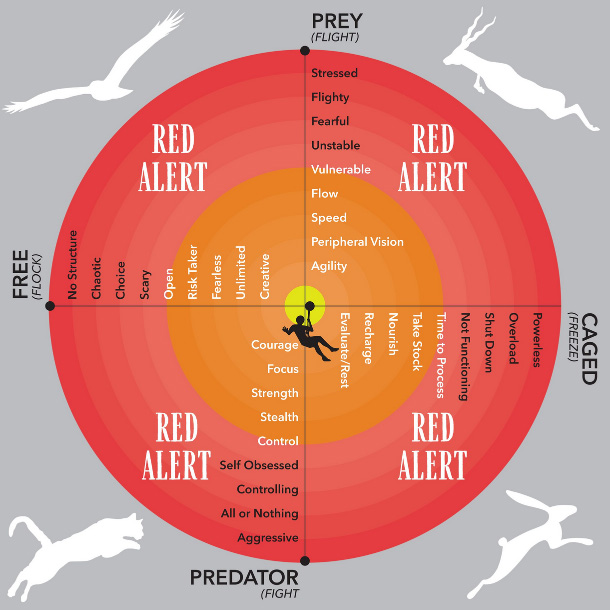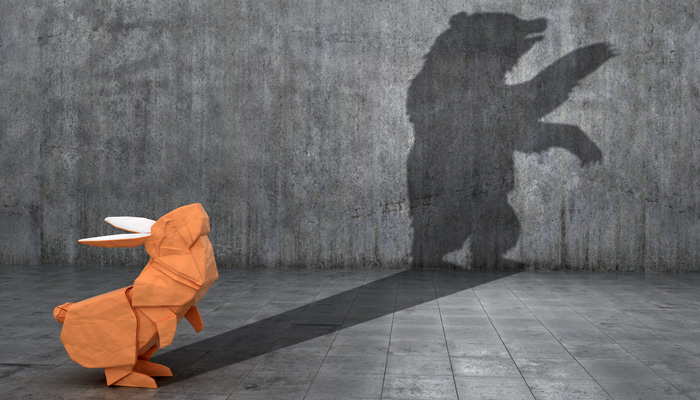In nature, nothing stays the same. Everything is moving all the time - the seasons, cycles of life, weather, abundance of food, scarcity, etc. Energy is everything and everywhere.
This continual change is often out of our human control. Think of the current COVID-19 crisis, for example. To be the best versions of ourselves, and therefore the best leaders, this change needs to be celebrated, not feared. As humans we tend to fear change and disruption, yet all change brings new opportunities. The tree that looks almost dead in the winter is bursting with vibrant blossom in spring. The frozen wasteland where it seems nothing will survive becomes the server of a bountiful harvest in the autumn. As business leaders, we can learn from nature.
When we look at the N-stinctive "Prey Predator Model" it becomes clear that leadership needs to adapt to change. Leadership of your life, or your business, has to be constantly flexing and adapting too. As leaders we are required to work on ourselves continually in order to be the best we can be, and to get the best out of our teams. Leadership is not static; we need to embrace fluidity. We have to understand energy and what is required to flow in the currents of change, and not fight that which is not in our control. By looking at the model we can see how energy flows from one side to the other and how we need to move to shift stuck energy.
Nature, by its own definition, is forced to adapt to unexpected changes in order to thrive. It is also designed to harness maximum productivity whilst minimising energy loss. In business terms nature seeks the maximum return on investment on its energy use versus its productivity. Again, as leaders we can learn from this natural model.
The Prey Predator Model is a diagnostic tool, a highly adaptive concept that can be tailored to any audience. Each 'Quadrant' has a set of positive attributes, but each also a 'shadow' side (a drawback, as it were).
 Depending on you as an individual (in this context "you" as a business leader) it is apparent that to make the most of a certain 'change' (whilst maximising productivity) different energies are required in each quadrant, and sometimes more than one energy is called for.
Depending on you as an individual (in this context "you" as a business leader) it is apparent that to make the most of a certain 'change' (whilst maximising productivity) different energies are required in each quadrant, and sometimes more than one energy is called for.
What energy is appropriate in each quadrant of the model?
To simplify, I believe that on a daily basis, we use four basic energies. These can easily be spotted in nature as:
- Blocking
- Pushing
- Drawing
- Pulling
Let's look more deeply at the model, whilst keeping in mind where "you" consider yourself as a leader to be. Be aware that with each leadership style there is always a positive and shadow side that is highlighted in the RED ALERT area on the model.
CAGED (Style of leadership) FREEZE (Outcome)
Shadow Side: Energy will be PUSHING & BLOCKING energy. Our personal freedom has been taken away, it is outside our control, comes from behind, often a shock, unexpected and scary - again, consider the global lockdown as a response to COVID-19. It's fast, definite, and there is no mistaking that you have been pushed into a scenario that is not of your choice. It can cause a deep scar, and the outcome might be positive or negative. The decision or outcome might have been taken for your own good, however you feel violated.
Positive Attribute: Sometimes we are grateful for an expert opinion, or an expert response, speed and the quality of decision making could save our lives. For example, a confident and pro-active response from the government to ensure that they have the situation under control. This 'validation' frees up internal energy to focus on our own wellbeing, thus feeling less CAGED.
In the wild instead of the "caged" state the freeze technique is used for survival, depicted on the model as a hare. A hare can literally use the freeze state to stay alive. When a predator is in hot pursuit, a wild hare will crouch down stock still, it's life force barely perceptible. Maybe by changing our perception from Caged to Freeze (a more positive lens), we can use our freeze-like state to take stock, nourish, recharge, process and evaluate for the rocky road ahead.
PREDATOR (Style of leadership) FIGHT (Outcome)
By definition a predator is an animal that hunts and kills other organisms (their prey) primarily for food. It may have to fight off competition. A Predator in business, is often used to describe a leadership style that is aggressively pursuing a goal or a dream. A predator's hunger and fear of starvation is what fuels its passion to hunt. A predator's fear of failure becomes its driver for success.
Shadow Side: The energy in the predator quadrant will be PULLING energy. All or nothing, my way or the highway, win or lose mentality. People in this quadrant behave as though they have the power and ability to make others suffer, they can enforce the regulations and rules, and can build a culture of fear. Their motto? You need to follow me, or I will drag you there.
Positive Attribute: Although the energy is still PULLING energy, it's from a different energetic perspective; we will get there together, despite everything. This energy is uplifting and rallying, confidence and positivity ooze out of every pore. You feel uplifted and held and you have no doubt that the job will be done. It galvanises people into action. The focus of this energy is that the job will be done for the benefit of everyone and there is nothing to fear. The sense is that we will be victorious in this fight, succeeding against all odds. This positive attribute is heavily dependent on motivated charismatic leadership qualities, especially body language.
FREE (Style of Leadership) FLOCK (Outcome)
Once we adopt this style of leadership, our openness and curiosity attracts like-minded others. Creativity, new ideas and innovation flourish, ego is diminished, and new thoughts germinate.
Shadow Side: This energy is INVITATIONAL. It is an invitation to join but could be perceived, by some as weak or following the herd, being a number rather than a leader or a voice. It could be seen as taking advantage of others' goodwill or being a bit flaky with no true direction. This energy can be difficult to shift into action and is easy to derail.
Positive Attribute: Come and join our flock, herd, group or team. We value our differences. All are welcome here and we want you to let your creativity run free. It's your choice to come to the table, to learn and to grow. We'll do it together; we'll be stronger and we'll unite.
PREY (Style of leadership) FLIGHT (Outcome)
Contrary to many peoples' views, I believe this is a very important leadership style because speed and agility in business are essential. After the Covid 19 pandemic, adopting this style might be the only way to survive. There are many businesses that will have to hit the ground running and be ready to change direction quickly to stay buoyant.
Shadow Side: The energy is PULLING energy. If one goes, they all go - and not always in the right direction - like lemmings over a cliff. There is a desire not to stand out or be left behind in the stampede. When you're on this side of the quadrant it's not easy to identify individuals in a mass of flow, and it can be difficult to turn the tide if it's going in the wrong direction.
Positive Attribute: The energy is INVITATIONAL. It is exciting, with a call to innovative, free and unencumbered by due process and heavy bureaucracy. The message is; join with me, let's work fast, let's be agile, let's get ahead of the other markets and ahead of the competition, let's get there first and give ourselves a huge advantage. Are you with me? Let's move!
How do we use this model?
Firstly, ask the question "what is it critical for me to resolve right now?" as a starting point.
Then ask; "where do I feel that I am?" on the model. And finally; "what attributes do it need in order to resolve the current challenge"? If where you are and where you need to be are not aligned, then perhaps a change is needed. You will see that the board has a zipwire or axis bisecting it into four quadrants, the man on the wire represents any context you wish to explore as a business. Consider the pathway you might need in order to get to where you need to be, from where you currently are. In essence, the model is a roadmap.
So, what can we learn from this model?
- Awareness - Where am I now?
- Understanding - Where do I need to be?
- Responding - How do I get there? (the roadmap)
- Applying - When should I make the change? (the reality)
In terms of business leadership, the Prey Predator Model invites us to consider where we are as individuals in relation to our own energy and actions. For example, do we see COVID-19 as a cage - or part of a natural cycle of change that can be embraced? Does this mean we feel frozen or are we up for a fight? It is clear from the model that there is no "one-size-fits-all" solution to these complex questions; instead it should be seen as a tool to be used to ensure a natural balance between under-action and over-action, being aware of straying into the red zone, and supporting maximum productivity during uncertain times, with minimal energy loss.

